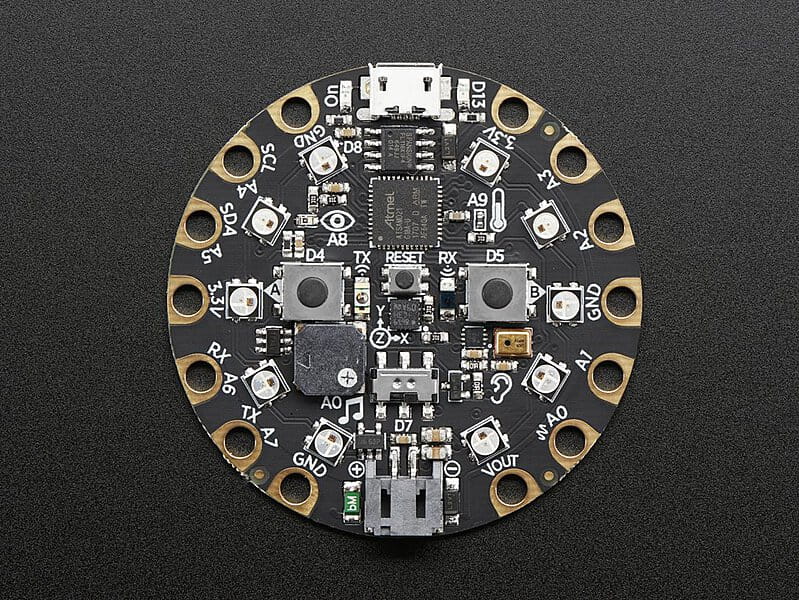
Circuit Playground Express by Adafruit
The Circuit Playground Express is Adafruit’s flagship educational board designed for CircuitPython. It brings the “batteries included” approach of Python to hardware by including an assortment of functionality built-in. It is one of the best beginner boards available. If you are new to hardware, then this is a great board to start with.
Technical details
- 10x mini NeoPixels, each one can display any color
- 1x Motion sensor (LIS3DH triple-axis accelerometer with tap detection, free-fall detection)
- 1x Temperature sensor (thermistor)
- 1x Light sensor (phototransistor). Can also act as a color sensor and pulse sensor.
- 1x Sound sensor (MEMS microphone)
- 1x Mini speaker with class D amplifier (7.5 mm magnetic speaker/buzzer)
- 2x Push buttons, labeled A and B
- 1x Slide switch
- Infrared receiver and transmitter - can receive and transmit any remote control codes, as well as send messages between Circuit Playground Expresses. Can also act as a proximity sensor.
- 8x alligator-clip friendly input/output pins
- Includes I2C, UART, 8 pins that can do analog inputs, multiple PWM output
- 7 pads can act as capacitive touch inputs and the 1 remaining is a true analog output
- Green “ON” LED so you know its powered
- Red
board.D13LED for basic blinking - Reset button
- ATSAMD21 ARM Cortex M0 Processor, running at 3.3 V and 48 MHz
- 2 MB of SPI Flash storage, used to store code and libraries.
- MicroUSB port for programming and debugging
- USB port can act like serial port, keyboard, mouse, joystick or MIDI!
Tutorials
Purchase
Contribute
Have some info to add for this board? Edit the source for this page here.
CircuitPython 10.0.3
This is the latest stable release of CircuitPython that will work with the Circuit Playground Express. Use this release if you are new to CircuitPython.
Modules included in this download
adafruit_bus_device adafruit_pixelbuf analogio array audiobusio audiocore audioio bitbangio board builtins busio busio.SPI busio.UART codeop collections countio digitalio errno locale math microcontroller neopixel_write nvm onewireio os pulseio pwmio rainbowio random rotaryio rtc storage struct supervisor sys time touchio usb_cdc usb_hid usb_midi warningsIncluded frozen(?) modules: adafruit_circuitplayground, adafruit_hid, adafruit_lis3dh, adafruit_thermistor, neopixel
Features: Speaker, Solder-Free Alligator Clip
CircuitPython 10.1.0-beta.1
This is the latest development release of CircuitPython that will work with the Circuit Playground Express.
Alpha development releases are early releases. They are unfinished, are likely to have bugs, and the features they provide may change. Beta releases may have some bugs and unfinished features, but should be suitable for many uses. A Release Candidate (rc) release is considered done and will become the next stable release, assuming no further issues are found.
Please try alpha, beta, and rc releases if you are able. Your testing is invaluable: it helps us uncover and find issues quickly.
Release Notes for 10.1.0-beta.1
Modules included in this download
adafruit_bus_device adafruit_pixelbuf analogio array audiobusio audiocore audioio bitbangio board builtins busio busio.SPI busio.UART codeop collections countio digitalio errno locale math microcontroller neopixel_write nvm onewireio os pulseio pwmio rainbowio random rotaryio rtc storage struct supervisor sys time touchio usb_cdc usb_hid usb_midi warningsIncluded frozen(?) modules: adafruit_circuitplayground, adafruit_hid, adafruit_lis3dh, adafruit_thermistor, neopixel
Features: Speaker, Solder-Free Alligator Clip
Absolute Newest
Every time we commit new code to CircuitPython we automatically build binaries for each board and language. The binaries are stored on Amazon S3, organized by board, and then by language. These releases are even newer than the development release listed above. Try them if you want the absolute latest and are feeling daring or want to see if a problem has been fixed.
Previous Versions of CircuitPython
All previous releases of CircuitPython are available for download from Amazon S3 through the button below. For very old releases, look in the OLD/ folder for each board. Release notes for each release are available at GitHub button below.
Older releases are useful for testing if you something appears to be broken in a newer release but used to work, or if you have older code that depends on features only available in an older release. Otherwise we recommend using the latest stable release.
Update UF2 Bootloader
Latest version: v3.16.0
The bootloader allows you to load CircuitPython, MakeCode, and Arduino programs. The bootloader is not CircuitPython. You can check the current version of your bootloader by looking in the INFO_UF2.TXT file when the BOOT drive is visible (FEATHERBOOT, CPLAYBOOT, etc.).
It is not necessary to update your bootloader if it is working fine. Read the release notes on GitHub to see what has been changed. In general, we recommend you not update the bootloader unless you know there is a problem with it or a support person has asked you to try updating it.
To update, first save the contents of CIRCUITPY, just in case. Then double-click the reset button to show the BOOT drive. Drag the update-bootloader .uf2 file to the BOOT drive. Wait a few tens of seconds for the bootloader to update; the BOOT drive will reappear. After you update, check INFO_UF2.TXT to verify that the bootloader version has been updated. Then you will need to reload CircuitPython.
